Poggio a Caiano
Poggio a Caiano is a town and comune in the province of Prato, Tuscany region Italy. The town, birthplace of Philip Mazzei, lies 9 kilometres (6 mi) south of the provincial capital of Prato.
Poggio a Caiano | |
|---|---|
| Comune di Poggio a Caiano | |
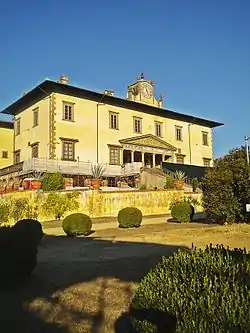 Medici villa in Poggio a Caiano | |
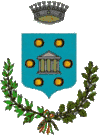 Coat of arms | |
Location of Poggio a Caiano 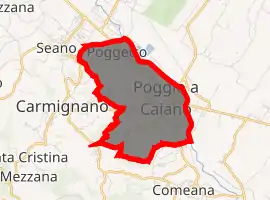
| |
 Poggio a Caiano Location of Poggio a Caiano in Italy  Poggio a Caiano Poggio a Caiano (Tuscany) | |
| Coordinates: 43°49′N 11°04′E | |
| Country | Italy |
| Region | Tuscany |
| Province | Prato (PO) |
| Frazioni | Bonistallo |
| Government | |
| • Mayor | Marco Martini |
| Area | |
| • Total | 5 km2 (2 sq mi) |
| Elevation | 45 m (148 ft) |
| Population (31 December 2013)[2] | |
| • Total | 10,019 |
| • Density | 2,000/km2 (5,200/sq mi) |
| Demonym(s) | Poggesi |
| Time zone | UTC+1 (CET) |
| • Summer (DST) | UTC+2 (CEST) |
| Postal code | 59016 |
| Dialing code | 055 |
| Patron saint | Santa Maria |
| Saint day | First Sunday of August |
| Website | Official website |
Sister towns
Poggio a Caiano has two sister cities:[3][4]
Main sights
The Medici villa
In 1473, a ruined fortified house at Poggio a Caiano called the Ambra, and land and a mill owned by Giovanni di Paolo Rucellai, were bought by Lorenzo de' Medici. Initially, only agricultural improvements were carried out; then in 1485, work began on the villa itself, to designs by Giuliano da Sangallo, who created a large fortified, quadrangular country house built around a central courtyard. A large central hall gave access to rooms with windows overlooking the surrounding countryside; at the time, this design was innovative.
On Lorenzo’s death in 1492, the villa was still largely unfinished; however, work resumed under Lorenzo’s second son, Giovanni, who became pope as Leo X. The central hall is named after this first Medici pope.[5]
In the following century, the Villa di Poggio a Caiano was used by successive Medici Grand Dukes of Tuscany. In 1587, Bianca Cappello and Francesco I de' Medici, Grand Duke of Tuscany died there within a day of one another after short illnesses; raising the still unsolved question of their poisoning by Francesco’s brother Ferdinand, who succeeded Francesco as Ferdinando I de' Medici, Grand Duke of Tuscany.[6] In the 17th and 18th centuries, the architects Giuseppe and Giovan Battista Ruggeri and Antonio Maria Ferri extended the villa. Major improvements to the gardens were also carried out after it came into the ownership of Maria Luisa, Queen of Etruria.
Following the Italian unification, the villa was refurbished and used by Victor Emmanuel II of Italy. The villa was donated to the Italian state in 1919. After a long period of neglect it became a national museum in 1984 and since that date has undergone restoration. It is now open to the public.
The main attractions of the villa are the Pontormo frescoes depicting Vertumnus and Pomona in the main salon. Most of the interior has lost its original furnishings, but these are being recreated to return the villa to the state described in a 1911 inventory, when it was a residence of the Savoyard.[7] The formal gardens, now somewhat wild, slope down to the Ombrone at the rear of the villa. Poggio also contains in the North East corner of the formal garden Cosimo I's tennis court (1543) intact but no longer in use. The palatoia (as the court was referred to in Tuscany – elsewhere known as "pallacorda") was built for Cosimo I at the same time as his court at Palazzo Pitti. The "tennis" of the Italian Renaissance was hugely popular at court and in the streets as in France where the sport is known as "jeu de paume". "Real tennis" (as it is called today), which requires a customised court with elaborate interior playing surfaces, is the model for modern tennis although the sport played in the Renaissance continues to be played today with 46 active courts in France, Australia, the UK and USA.
The villa was featured in the 1965 John Schlesinger film Darling.
Churches
- Santa Maria del Rosario in Poggio a Caiano
- Church at the Institute of Minim Sisters in Poggio a Caiano
- Parish church in Poggetto
- Chapel at Villa Castellaccio
- San Francesco in Bonistallo
- Santa Maria in Bonistallo
- Santa Cristina in Santa Cristina in Pilli
- Diana's temple at Medici Villa in Poggio a Caiano
Villas
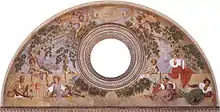
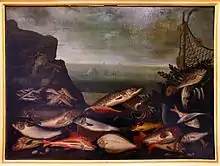
- Medici Villa in Poggio a Caiano
- Villa Cirri in Poggio a Caiano
- Villa Pacetti in Poggio a Caiano
- Villa Il Cerretino in Il Cerretino
- Villa Il Poggiale in Il Poggiale
- Villa Il Castellaccio in Madonna del Violo
- Villa Magra in Madonna del Violo
- Villa Mastringalla in Poggetto
Other sights
- Medici Park in Poggetto
- Old palace with tower in Santa Cristina in Pilli
- Birthplace of Philip Mazzei in Poggio a Caiano
- Bacco's fountain in Poggio a Caiano
- Town hall in Poggio a Caiano
- Medici Stables in Poggio a Caiano
Feasts
- Siege at the Villa in Poggio a Caiano, held in September
- Antique fair in Poggio a Caiano
- Festival delle Colline, held in the whole province of Prato
References
- "Superficie di Comuni Province e Regioni italiane al 9 ottobre 2011". Istat. Retrieved 16 March 2019.
- "Popolazione Residente al 1° Gennaio 2018". Istat. Retrieved 16 March 2019.
- "Sister City International Listings - Italy". Sister Cities International. Archived from the original on 2010-08-31. Retrieved 2011-02-22.
- "Comune di Poggio a Caiano - Gemellaggio Saharawi". Comune di Poggio a Caiano. Archived from the original on 2011-09-26. Retrieved 2011-04-22.
- Lapi Ballerini The Medici Villas, 2003
- C.G.F. Young The Medici
- Roberta Passalacqua La Villa medicea di Poggio a Caiano, 2000
External links
| Wikimedia Commons has media related to Poggio a Caiano. |
- Official tourism website (in English)
- arttrav Medici Villa Poggio a Caiano information from arttrav.com
- Museums in Florence - The Medici Villa of Poggio A Caiano